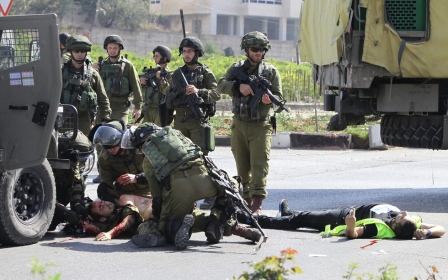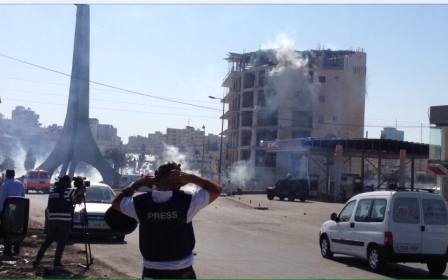Israeli settler shoots dead Palestinian in Hebron, two others killed in attempted stabbings

An Israeli settler shot dead a Palestinian teenager on Saturday in the occupied West Bank city of Hebron, a local activist told Middle East Eye.
Eighteen-year-old Fadel al Qawasmeh was killed by an armed settler after passing through an Israeli army checkpoint at the entrance to Shehada Street, in Hebron’s flashpoint Old City, just before 0600 GMT.
"The soldiers checked him and his bag then allowed him to pass through,” said Hashim Alazzah. “A settler then shot and killed him. The boy just wanted to pass through the old city to reach his home on the other side.”
Israeli police, however, said that the Palestinian teenager had tried but failed to stab a settler. The police said the settler had responded to the stabbing attempt by shooting dead Qawasmeh.
Local Palestinian residents dismissed reports of Qawasmeh trying to stab a soldier, claiming that the young man was unarmed until after he was dead.
“This morning my daughter was sitting on the window and suddenly screamed, after we heard a sound of four bullets being fired. My daughter said that the settlers were annoying, assaulting and cursing a young Palestinian man, and when he tried to get away one of the settlers shot him. And when we looked out of the window we saw the young Palestinian man lying on the ground, and there is a settlers in front of carrying a weapon and there was no knife!," said 55-year-old Mufeed Sharbati, who lives on Shehada Street.
“My brother Zidan Sharbati who is an activist in the youth group against settlement filmed the incident and filmed when the soldiers threw a fruit knife near the young man.”
Video footage shared on social media websites appeared to show an armed settler standing over Qawasmeh’s body, while Israeli soldiers surrounded the scene and drop an object next to the slain Palestinian.
Locals told Palestinian news agency Maan that they saw settlers "distributing candies" after the shooting.
In the video the armed settler is not arrested or disarmed by the soldiers, something Alazzah says he has grown used to living in Hebron.
"The settlers feel confident that they have a free pass to kill Palestinians here," he said. "We have asked the soldiers to help stop the settlers but they said it’s not their role and that we should leave the city."
Alazzah said in Hebron, where 500 settlers live under armed guard in a Palestinian city, Israelis have been emboldened to kill Palestinians after recent remarks by the country’s interior minister.
Silvan Shalom said this week that Israel must “vomit the bloodthirsty murderers from among us”.
A second Palestinian was killed in Hebron on Saturday morning, when a woman attempted to stab a female soldier, police said.
Local activists sent Middle East Eye a photo of the dead young woman, 16-year-old Bayan Aselah.
Separately in occupied East Jerusalem a third Palestinian was shot and killed by Israeli forces when he tried to stab a soldier at a checkpoint, Israeli police said.
Police spokesperson Louba Samri said the Palestinian, who was not immediately identified, was killed on the spot after he tried to stab the soldier in the Israeli settlement neighbourhood of Armon Hanetsiv, also known as East Talpiot.
Nearly 40 Palestinians have been killed and hundreds wounded this month, as violence grips Israel and Palestine, while seven Israelis have died in a wave of knife and gun attacks.
The violence has led many, including Palestinian politician Mustafa Barghouti, to declare the beginning of a third intifada, or uprising.
In the Palestinian uprisings of 1987-1993 and 2000-2005, thousands were killed and many more wounded in near daily violence.
The latest incidents come a day after Palestinians called for a "Friday of revolution" against Israel.
Middle East Eye propose une couverture et une analyse indépendantes et incomparables du Moyen-Orient, de l’Afrique du Nord et d’autres régions du monde. Pour en savoir plus sur la reprise de ce contenu et les frais qui s’appliquent, veuillez remplir ce formulaire [en anglais]. Pour en savoir plus sur MEE, cliquez ici [en anglais].





